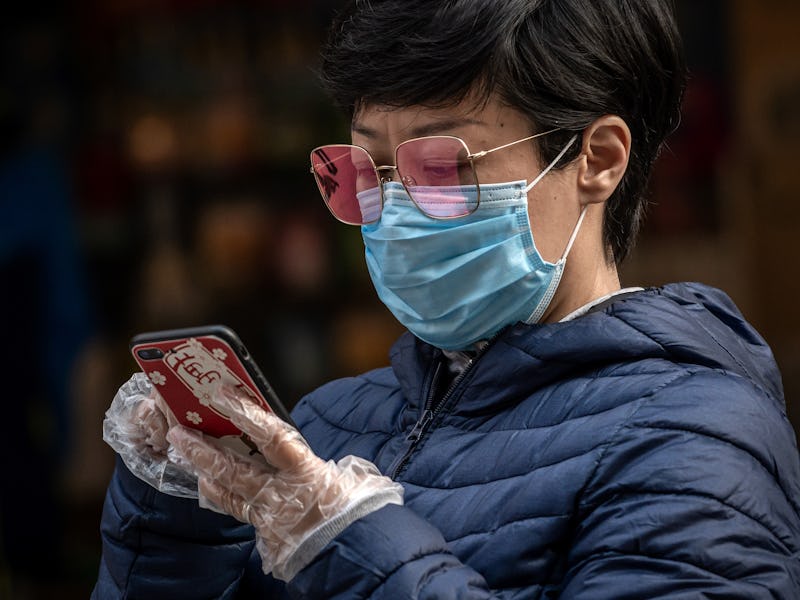Your phone could hold the key to unlocking a win over Covid-19 -- MIT study
The era of social distancing could give way to a new smartphone-powered setup.

The smartphone in your pocket could aid in the fight on the coronavirus pandemic, claims research published Thursday.
Researchers from the Massachusetts Institute of Technology have been leading a team exploring a method of using bluetooth tech and your phone to trace human-to-human contact.
How it works — The system asks phones to constantly send out a random string of numbers while keeping a virtual ear out for other phones' strings of numbers.
The phones then keep a virtual log of the numbers that came into contact with a user.
When a patient visits a hospital, they can share this information with a database. Others can then scan the database to see if they have been in contact with anyone with the virus. The system can then send a notification advising them with the next steps they can take.
The tech it uses — The highj-tech system uses existing Bluetooth wireless technology, protects user privacy by constantly changing the phone's signals, and could help teams understand who came into contact with coronavirus patients.
Ron Rivest, an MIT professor and principal investigator of the project, explains: “I keep track of what I’ve broadcasted, and you keep track of what you’ve heard, and this will allow us to tell if someone was in close proximity to an infected person."
The idea could enable a form of fighting the coronavirus called "contact tracing."
Smartphones could collect vital data about recent points of contact.
"Contact tracing" can play a big role in mitigating the spread of Covid-19. This involves checking who has been in contact with people, actively investigating the links to track who may be at risk of the disease. The World Health Organization notes how contact tracing helped control Ebola outbreaks in Africa.
The Straits Times explained Singapore's highly successful contact tracing process for coronavirus in a new video (Watch it below). It involves creating a map of a patient's movements over the past 14 days, interviewing them to trace their whereabouts and confirming that information with other relevant companies like airlines. In the case of a flight, for example, the team identifies who the patient was sitting near.
Back to the technology — This contact tracing system, and others like it, create some privacy questions. What if people don't want their locations traced over the past 14 days, or would at least prefer to keep that information anonymous?
The MIT system helps to alleviate these issues and more. It focuses on short-range Bluetooth signals emitted by phones. Devices signed up to the system can log the "chirps" of random numbers it picks up from other devices. If a person tests positive, they can upload their "chips" over the past 14 days, the time period when they have infected others. Other users can scan the database to see if they've been in contact with a coronavirus patient and if so what to do next.
The researchers claim that their inspiration for the system came from Find My, Apple's tool for locating lost iPhones and other supported gadgets.
Marc Zissman, an associate head of MIT Lincoln Laboratory and co-principal investigator of the project, explains:
"If my phone is lost, it can start broadcasting a Bluetooth signal that’s just a random number; it’s like being in the middle of the ocean and waving a light. If someone walks by with Bluetooth enabled, their phone doesn’t know anything about me; it will just tell Apple, ‘Hey, I saw this light.'"
What about privacy? MIT's system is designed to protect user privacy. It does this by using what Rivest calls "cryptographic techniques," constantly changing the "chirps" that are emitted to ensure they can't be linked back to any particular individual.
The system doesn't log every single "chirp" it detects. It only logs those where the other person was around six feet away or closer and those where the phone stayed within range for a period of time. This ensures it only logs those with a significant chance of actually passing on the virus.
The team has been working to iron out the kinks, notably in getting iPhones and Android smartphones to recognize each others' "chirps." The group managed to resolve this particular issue late last week. The aim is now to speak with Apple, Google and Microsoft to help with the implementation process.
Covid-19 has wrought havoc on societies and economies, but this new research could prove an effective means of fighting the outbreak that also protects civil liberties. One of the big issues around fighting the virus — which has spread around the world over the course of — is that it spreads rather easily through social contact. Symptoms vary, and it can take nearly two weeks for some to show any symptoms at all, at which point they may have spread the disease further. Governments around the world have implemented strict lockdown laws, barring people from leaving their homes, except for essential reasons like buying more food. This "social distancing" strategy aims to reduce the amount of contact between people, giving health infrastructure a chance to tackle the large rise in patients.
In contrast to what 5G conspiracy theories may have you believe, it seems smartphones may help prevent the spread of coronavirus.